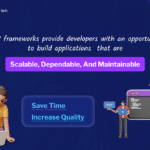
In the sphere of web development there is WordPress. A blogging tool that has now transformed into a full-fledged content management system (CMS), WordPress now powers more than 40 percent of the websites on the planet. To summarize, no matter if you need a personal blog or an e-shop or company’s Web site, WordPress contains all the required elements and options.
Beginning with the basics of WordPress development up to which level one can modify his/her site to offer great performance to the users; this blog will offer all the details.
1. Why Choose WordPress?
Let’s first discuss why WordPress is the favourite platform for both developers and business people before we move on to the actual development process:
-
- Open Source: WordPress is free and open-source, so you have the full power to make it your own.
- User-Friendly: It’s very easy for beginners and no coding experience is needed although developers can use advanced coding for customizations.
- SEO-Friendly: WordPress is a platform created with SEO in consideration, so you can design your web pages without any hassle and they will be SEO encouraged.
- Extensive Plugin Library: With a library of over 58,000 plugins, you can enrich your website to almost any extent purpose whether it be e-commerce, social media, or analytics.
- Responsive and Mobile-Ready: WordPress themes and plugins are designed to ensure that your website is compatible with all devices and looks great.
2. Getting Started with WordPress Development
Here’s a step-by-step guide to getting started with WordPress development:
Step 1: Choose a Hosting Provider and Domain
Furthermore, a site without a home looks strange. A big brand hosting services provider (think Bluehost, SiteGround, or even WP Engine) will be necessary for you. It is best to pick your domain name that conveys your business or the brand you own.
Step 2: Installing WordPress
One-click installation of WordPress is a very common feature among hosting companies. Thus, it takes very little effort to pass great bye and run the whole thing. After the installation process, you will see the WordPress dashboard where you can manage your site.
Step 3: Choose a Theme
A theme is the type of foundation that your website’s design is. WordPress has plenty of free and paid top themes that cover all industries. You can either install a theme straight from the WordPress Theme Directory or get it from different marketplaces like ThemeForest or Elegant Themes
Step 4: Installing Essential Plugins
- Plugins are one of such approaches you can use to extend the capabilities and in effect, introduce additional constituents into the WordPress site. These are some of the essential plugins that every site should have:This article covers the most useful plugins, which each person needs to add to the site:
- Yoast SEO: The website aiming to be among the first ten on the google website search.
- WooCommerce: All right then, let me assume that today you find yourself in desperate need of an e-shopping site. WordPress remains the choice of a CMS and WooCommerce is the plugin which will unleash the store.
- Elementor: In fact, there is a page builder in the stage of development through which one can simply drag n drop his pages into layout like these.
- Wordfence: When setting up the rules, a number of different stakeholders/agencies may demand more securities to be placed in the system than are initially available.
- Contact Form 7: This is among the best and simplest plug-ins that enable one to develop a contact form on the website without stress.
Step 5: Customize Your Website
The WordPress Customizer means you can change your site’s look by customizing it by changing your logo, colors, fonts, and more. In addition to editing your theme files, you can also create a child theme that makes it possible to avoid overwriting changes when updating your software if you know HTML, CSS, and PHP.
3. Developing Custom Themes and Plugins

The developers who use WordPress are like a child in a playground full of options. Here’s how you can take your site beyond pre-built themes and plugins:
Creating a custom theme gives you the opportunity to make it look and feel exactly how you want it to be. Start with writing the necessary files such as style.css and index.php, and then structure your site using the PHP and HTML.
WordPress has a theme hierarchy, which means you can have different template files for different types of content, like posts, pages, and archives. You will employ the WordPress Loop for Dynamic Content, which scans through each of the posts and displays the content.
Plugins allow for custom functionality on WordPress sites. To build your own, first create a new folder in the wp-content/plugins directory and add your plugin files. Plugins on WordPress are programmed in PHP, and they work along with the WordPress Core API in order to make the site more functional. To illustrate, you might design a plug-in that allows you to customize a post type, connect to an API, or add advanced features to an e-commerce site.
4. Best Practices for WordPress Development
- The best practices, regardless of whether you are a complete newcomer or a pro wizard in the web development area, will render your website fine-tuned, trouble-free, and easily maintained.
- Follow coding standards: WordPress project outlined coding standards for PHP, HTML, and CSS languages. These are useful in making your code readable, thus preventing you from making mistakes when you need to update or add a new feature.
- Child Themes: The very first thing one should bear in mind when editing the parent theme is to save all his modifications done so far in a new child theme created by him. This way, any modification doesn’t get trumped from an update of the parent theme. Of course, keep your site as fast as possible. Check-in with caching instruments such as WP Super Cache or W3 Total Cache. REDUCE image size when using them.
- Prioritize security: It is an integral part of your business. Add security protocols like two-step verification, continuous improvement, and way of data recovery. Furthermore, there are several plugins available that help you to monitor as well as securing your site, which includes iThemes Security.
- Mobile-Friendly: Since most of the users usually come from mobiles, it’s high time to develop mobile-friendly websites. Thus, make your WordPress site responsive and pretty well designed for mobile devices.
5. WordPress SEO Optimization

- WordPress, because of its nature, is SEO-friendly. However, a few tweaks will take you to the next level, including:
- Use an SEO plugin: Make use of plugins like Yoast SEO or Rank Math; these will go a long way in guiding you with on-page SEO elements like meta tags, title tags, and even the creation of XML sitemaps.
- Optimize Permalinks: Avoid using default URLs; instead, you could use SEO-friendly ones which you are able to set via Settings >> Permalinks by changing the structure to post name.
- Structural Content: Establish the content with headings such as H1, H2, H3, etc., to make the material search-engine and user-friendly. Responsive Mobile: The full responsiveness of your website will help attain the highest ranking in Google’s first mobile index.
Conclusion
WordPress development gives endless possibilities of dynamic and custom website development for everything a business may need. Whether it is the first blog or another development task, flexibility together with a great community and resources makes WordPress the perfect platform for modern web development.
The skill of mastering WordPress development will take you into making a website that will not only be developed on what you have in mind but also grow as big as it should be.





 Book call
Book call



